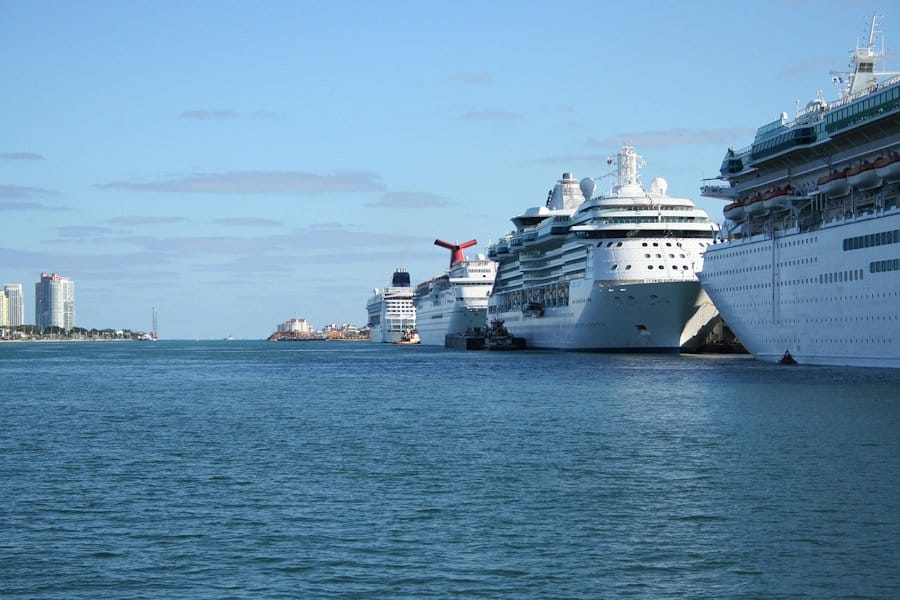Home » Do cruise ships have free WiFi or Internet?
Do cruise ships have free WiFi or Internet?
Updated May 7th, 2025
On ships belonging to major cruise lines like Royal Caribbean, Carnival, Celebrity, Holland America, Princess and Norwegian, Wi-Fi is installed throughout public areas and in staterooms for use with your own device. But it’s not free.
Access to Wi-Fi and internet services is a key consideration for many cruise passengers who wish to stay connected for work, communication, or entertainment.
While cruise ships have made significant strides in providing reliable internet, the availability, quality, and cost of connectivity vary across cruise lines, ships, and itineraries.
This article explores the state of Wi-Fi on cruise ships, factors affecting connectivity, and options for accessing the internet while in port.
If you are wondering about a specific cruise line, check out the information here: Cruise Ships & Wifi.
Internet Availability on Cruise Ships
Modern cruise ships are equipped with satellite-based internet systems to provide connectivity at sea, a significant advancement from the limited and slow connections of the past.
Major cruise lines, such as Royal Caribbean, Carnival Cruises, Norwegian, and Princess, offer Wi-Fi across their fleets, accessible in staterooms, public areas, and even some outdoor decks.
Newer ships, like Royal Caribbean’s Icon-class or Celebrity’s Edge-class, feature advanced satellite technology, such as low-earth-orbit systems (e.g., Starlink), which provide faster and more reliable connections compared to traditional geostationary satellites.
Internet access is rarely free, as cruise lines typically charge for Wi-Fi packages due to the high cost of satellite bandwidth. However, some luxury and ultra-luxury lines, such as Regent Seven Seas, Silversea, and Viking, include complimentary Wi-Fi in their offerings, often with generous data allowances or unlimited access for suite guests.
Mainstream cruise lines like Disney, Holland America, and MSC Cruises usually require passengers to purchase Wi-Fi packages, with options ranging from basic plans for messaging to premium plans for streaming or video calls.
Types of Wi-Fi Packages
Cruise lines offer tiered Wi-Fi plans to suit different needs:
- Basic Plans: Designed for light use, such as emailing, texting, or browsing social media. These plans often have data caps or slower speeds, suitable for apps like WhatsApp or iMessage.
- Mid-Tier Plans: Support web browsing, social media uploads, and limited video streaming. These are ideal for staying connected with moderate usage.
- Premium Plans: Offer higher speeds for video calls, streaming services like Netflix, or work-related tasks. These plans may include multiple device connections.
- Device-Specific Plans: Some lines, like Carnival or Norwegian, allow passengers to purchase access for a single device or multiple devices, with restrictions on simultaneous use for single-device plans.
Passengers should check the cruise line’s website or contact guest services before booking to understand plan details, as offerings vary by ship and itinerary. Luxury lines may provide unlimited Wi-Fi for all guests, while mainstream lines often limit free access to loyalty program members or suite passengers.
Factors Affecting Wi-Fi Performance
Several factors influence the quality and reliability of internet access on cruise ships:
- Ship Technology: Newer ships with advanced satellite systems, such as Starlink on select Royal Caribbean or Celebrity vessels, offer faster and more stable connections. Older ships may rely on slower, traditional satellites.
- Location and Itinerary: Connectivity can weaken in remote areas, such as polar regions, parts of Alaska, or the South Pacific, where satellite coverage is limited. Coastal routes, like the Mediterranean or Caribbean, typically have better signals.
- Passenger Demand: High usage during peak times, such as evenings, can slow speeds, especially on larger ships with thousands of passengers.
- Weather Conditions: Heavy rain, storms, or other adverse weather can disrupt satellite signals, leading to temporary outages or reduced performance.
Connecting to Wi-Fi Onboard
To access Wi-Fi on a cruise ship, passengers typically follow these steps:
- Purchase a Plan: Select a Wi-Fi package through the cruise line’s website before sailing, via the onboard app, or at the guest services desk. Pre-purchasing often provides better value.
- Connect to the Network: Enable Wi-Fi on your device and select the ship’s network (e.g., “RoyalWiFi” or “CarnivalHub”). Open a browser to access the login portal.
- Log In: Enter the provided credentials, such as a username, password, or booking number, to activate the connection. Some ships use an onboard app for seamless access.
- Manage Usage: Monitor data usage through the cruise line’s app or guest services to avoid exceeding plan limits, especially on basic or mid-tier plans.
Passengers should enable airplane mode to avoid roaming charges and connect only to the ship’s Wi-Fi. For security, using a VPN is recommended when accessing sensitive information, as public Wi-Fi networks, even on ships, may be vulnerable to data breaches.
Accessing Wi-Fi or Internet in Port
When a cruise ship is docked at a port, passengers have several options to access the internet without relying on the ship’s Wi-Fi:
- Local Wi-Fi Hotspots: Many ports offer free or paid Wi-Fi at cruise terminals, cafes, restaurants, or public areas. For example, ports like Nassau, Barcelona, or Vancouver often have Wi-Fi in terminal buildings or nearby establishments. To connect, select the network, agree to terms, and enter any required credentials or payment details.
- Local SIM Cards or eSIMs: Purchase a local SIM card or activate an eSIM for data in the port country. This is ideal for longer port stays or frequent travelers. SIM cards are available at airports, convenience stores, or mobile shops in ports like Miami, Rome, or Sydney. Ensure your device is unlocked and compatible with local networks.
- Mobile Data Plans: Use your existing mobile provider’s international roaming plan, if available, for data access in port. Contact your provider before travel to confirm coverage and avoid unexpected charges.
- Portable Wi-Fi Devices: Rent or purchase a portable Wi-Fi hotspot for use in port. These devices provide a private network and are useful in destinations with limited public Wi-Fi, such as smaller Caribbean islands or remote Alaskan ports.
To connect to local Wi-Fi or mobile data in port, disable the ship’s Wi-Fi, turn off airplane mode, and select the desired network or insert a local SIM. Be cautious with public Wi-Fi, as it may lack encryption, and avoid accessing sensitive accounts without a VPN.
Tips for Managing Connectivity
To optimize internet access during a cruise:
- Plan Ahead: Research Wi-Fi packages and port connectivity options before sailing to select the most suitable plan.
- Conserve Data: Use offline modes for apps, download content before sailing, and limit streaming to preserve data on restricted plans.
- Check Port Wi-Fi: Ask crew members or check port guides for reliable Wi-Fi spots in each destination.
- Test Connections: Verify Wi-Fi or mobile data functionality in port to ensure access for navigation, communication, or excursion planning.
- Contact Guest Services: If onboard Wi-Fi is slow or unavailable, report issues promptly for troubleshooting or potential compensation.
Cruise Line Variations
Wi-Fi offerings differ across cruise lines. Luxury lines like Silversea and Seabourn often include unlimited Wi-Fi, while mainstream lines like Carnival and MSC Cruises charge for access, with exceptions for loyalty members.
Expedition cruises, such as those by Lindblad or Hurtigruten, may have limited connectivity due to remote itineraries. Checking ship-specific details is essential, as older vessels may have slower connections compared to newer ones equipped with advanced systems.
In Conclusion
While free Wi-Fi is uncommon on most cruise ships, reliable internet access is widely available through paid packages or complimentary offerings on luxury lines. Connectivity has improved significantly with modern satellite technology, but performance depends on ship design, itinerary, and passenger demand.
In port, passengers can leverage local Wi-Fi, SIM cards, or mobile data for cost-effective alternatives. By planning ahead and understanding connectivity options, travelers can stay connected seamlessly throughout their cruise.

RECENT POSTS

Discover the Cruise Ports of Eastern Canada & Quebec

Inside the Worst Cruise Lines: Lowest-Rated Ships and Why They Disappoint

Snorkeling in Cozumel: A Cruise Passenger’s Guide for Your Port Day

How to Make the Most of a Short Port Stop in Cozumel

Cruise Ship Ports in Florida

